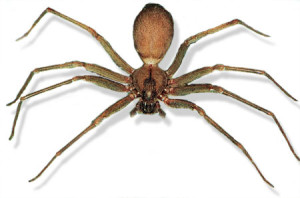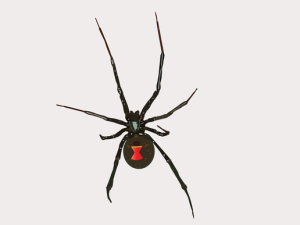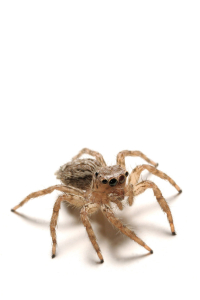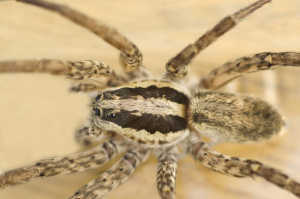There are many ways to address the unwelcome presence of spiders. Taking preventative measures to keep spiders out and understanding some of the facts about the spider species are a good place to start. When you get to the point where you feel the need for support, contact Mug-A-Bug for pest control options.
Brown Recluse Spider
Loxosceles reclusa

APPEARANCE: Yellowish to brown, with a dark brown violin-shaped dorsal marking; 5/8 to 1/2 inch long.
HABITS: Can be found outside under rocks, leaves, debris, bark, woodpiles, utility boxes; found inside in storage areas such as closets, attics, bedrooms; usually found close to the ground.
DIET: Cockroaches, crickets and other soft-bodied insects.
REPRODUCTION: Mating occurs from Feb. to Oct.; 40 to 50 eggs are deposited in off-white, round silken cases; lifetime averages from one to two years.
OTHER INFORMATION: Bites when disturbed; bites can cause a disfiguring scar.
Black Widow Spider
Genus Latrodectus

APPEARANCE: Female is 1/2 inch long; shiny black, with hourglass-shaped red mark on underside of abdomen.
HABITS: Can be found almost anywhere, indoors or out; prefer to build their nests close to the ground.
DIET: Insects trapped in web made by female.
REPRODUCTION: Contrary to popular belief, female is usually unsuccessful in any attempt to eat male after mating; 300 to 400 eggs are laid in silken cocoon, hatch in about ten days.
OTHER INFORMATION: Black widows are not aggressive, and will not bite unless provoked; bites are poisonous, but rarely fatal; if bitten, seek medical attention and contact poison control.
House Spider
Tegenaria domestica

APPEARANCE: The body ranges up to 3/8-inch in length, with a spherical abdomen. Typically brown or tan in color with various markings.
HABITS: “House” spiders are those web-building spiders common in the corners and garages of most homes and buildings. The spiderlings float, or “balloon,” on tiny strands of silk onto buildings from wooded areas or fields. Once on the building they construct webs outside or crawl inside to find a suitable web site.
DIET: Flying insects make up most of their diet, so these spiders are most common around windows and doorways.
REPRODUCTION: The male and female house spider often live together on the same web where they are able to reproduce. The female lays her eggs in a brownish, pear shaped cocoon that is 6 to 9 mm in diameter. Several cocoons can be made in one season and they simply hang in the web until they are ready to hatch.
OTHER INFORMATION: If a web doesn’t yield a spider many insects, they will abandon it and build another. This can lead to a large accumulation of spider webs, which are sticky and difficult to clean up. People seldom get bit from these spiders, and the bites are not very harmful.
Wolf Spider
Family Lycosidae

APPEARANCE: Wolf spiders range from about 1/2 inch to 2 inches in length, hairy, and are typically brown to gray in color with various markings or lines. Wolf spider mothers carry their large egg sacs around with them. When the young spiderlings hatch they climb onto their mother’s back and ride around until partially grown. Wolf spiders are not poisonous, though as with all spiders, bites may cause reactions in certain individuals.
HABITS: Common household pest in the fall when they are looking for a warm place to overwinter. They are commonly found around doors, windows, house plants, basements, garages, and in almost all terrestrial habitats. They do not spin a web but roam at night to hunt for food. Wolf spiders are often confused with the brown recluse, but they lack the unmistakable violin-shaped marking behind the head. The wolf spider is shy and seeks to run away when disturbed.
DIET: The wolf spider is a true predator. He waits in ambush to attack the unsuspecting insect. The wolf spider will impale his prey with sharp fangs and inject venom. Digestive juices are injected into the insect to liquefy its internal organs. The resulting ‘soup’ is then sucked out.
Wolf spiders hide away to devour their prey. They are not fussy eaters and have been known to resort to cannibalism when given the chance.
REPRODUCTION: Each female usually rears 2-4 sacs of eggs in her two year lifespan.
OTHER INFORMATION: Wolf spiders live all over the world in very diverse ecosystems. Most wolf spiders need open areas for a clear view of their prey and to find mates, so they avoid thickly vegetated areas.
Locations:
We service the following areas/locations: Colorado Springs, Pueblo, Pueblo West, Calhan, Falcon, Peyton, Elbert, Ellicott, Security, Widefield, Black Forest, Monument, Larkspur, Palmer Lake, Manitou Springs, Fort Carson, Peterson Air Force Base, Schriever Air Force Base, and the US Air Force Academy.